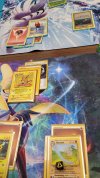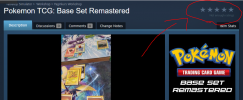Base Set Rebalanced 1.1 Patch
Sup.
Removing Discard Acceleration
While this is not the first change I have implemented, I must explain it first, because it'll make some further choices a bit more obvious. In short, I have removed (almost) all options for discarding Energy cards from your hand straight into the discard pile. The reason for that was simple - regularly, we can treat "hand acceleration" and "discard acceleration" as equal. They have their differences, pros and cons, but the outcome is largely the same. What I have tried doing is move "discard acceleration" more towards "discard re-acceleration", that is a catch-up mechanic that is allowed to have cards that are a bit more powerful. No changes needed on that front - Gym Badge is already a very strong card, perhaps too strong and too universal, so this will make it weaker without any changes to the wording itself.
Below is a Super Potion, a card that got its wording changed slightly to fit this adjustment.
Supporter Changes
This is a big change, probably the biggest. Many of the Supporters in BSR were experiments and I am happy to say a lot was learned from them. The only "drawing supporter" that remains unchanged is Bill, the classic "draw 3" supporter - everything else is getting a facelift.
Lets start with Professor Oak. My previous Professor Oak had the right idea, but it was simply too strong - it was just a "draw 5" Supporter, which didn't have much downside beside these terrible situations where your hand is already in shambles. I wanted to maintain the general idea, but slow the game down severely, especially since decks tended to draw their entire card stock very quickly. Here's what I have.
So, Professor Oak is now objectively a "draw 2" Supporter, but you get to see five cards from the top of your deck. Reshuffling is good, especially with how many dead cards tend to be held in Pokemon TCG. The intended playstyle of "holding many cards" is also maintained, as a hefty hand size makes this card more optimal and less of a "draw 2".
Second comes the evil counterpart of Professor Oak - Impostor Oak. Here, no big changes were made - it might be the case that draw 6 is WAY stronger than draw 2, but I am not sure that it'll be completely overpowering. The change that was made is to the discard mechanic, now obviously discarding everything but the Energies, then drawing up to 6. It's not as slick of a wording as it used to be, but gameplay takes precedence here.
Next is Lass, previously "both players shuffle their hands, then draw 6". I am not a fan of this effect - it's very confusing, it doesn't play well and, most importantly, it makes the players reshuffle their hands constantly. I wanted to keep the effect of messing with your opponent's hand, but leave space for choices to be made, instead of completely nuking their hand arrangement. As such, Lass is now an "equalizer", allowing each player to either draw or reshuffle back to 5 cards. They must reshuffle because, again, they may not discard energies and there's no easy way of policing that.
Finally, we've got a brand new draw Supporter. This came about, because frankly having just 4 drawing supporters made for a very boring selection - if you are planning on using 12 supporters, you'll be using 3/4ths of the entire cast. Now it'll be just the majority and perhaps with a bit more choice. I always treated Mr Fuji as a "free slot" and gave him a very inoffensive ability previously, although it did turn out that healing decks are absolutely a strong contender. That said, trying to find the right effect was not easy. I will spare you the details and just show you the card.
So, it's a Supporter that technically can draw a clean 4, but also has the potential of drawing three, two or even a disastrous one. The testing will show how good it is in reality.
Actual Nerfs
Now we will discuss the cards that don't get reworks, but actual nerfs - and the biggest offender here is Raichu. I have talked about this card in my initial release post, but the bottom line is - the wording is confusing and it deals too much damage. Both of these things got addressed, with a simple ability and 10 less damage on its first attack.
In the same vein, Jolteon got a nerf that also tackled a similar "switch" ability. This is supposed to be a support Pokemon, so it made no sense that it was also a very strong attacker.
Raichu Counter
On top of the nerfs above, I have changed one more card to tackle the idea of "switching decks". Sandslash had a pretty mediocre ability that was supposed to work in switching decks, but dealing 10 for free wasn't really impressive. I am really surprised I have not gone with this version of the ability instead from the start - it even existed, word for word, on the first Forretress card and even had the name "Spikes" to boot. Now Sandslash is a Raichu killer, hitting for weakness and placing damage counters on every switch.
Tidying Up
When I was writing about some design rules for this format, one of them was to make the attack costs more colorless. I have sometimes forgot to do this, so a few cards got their attack costs "de-colorified".















